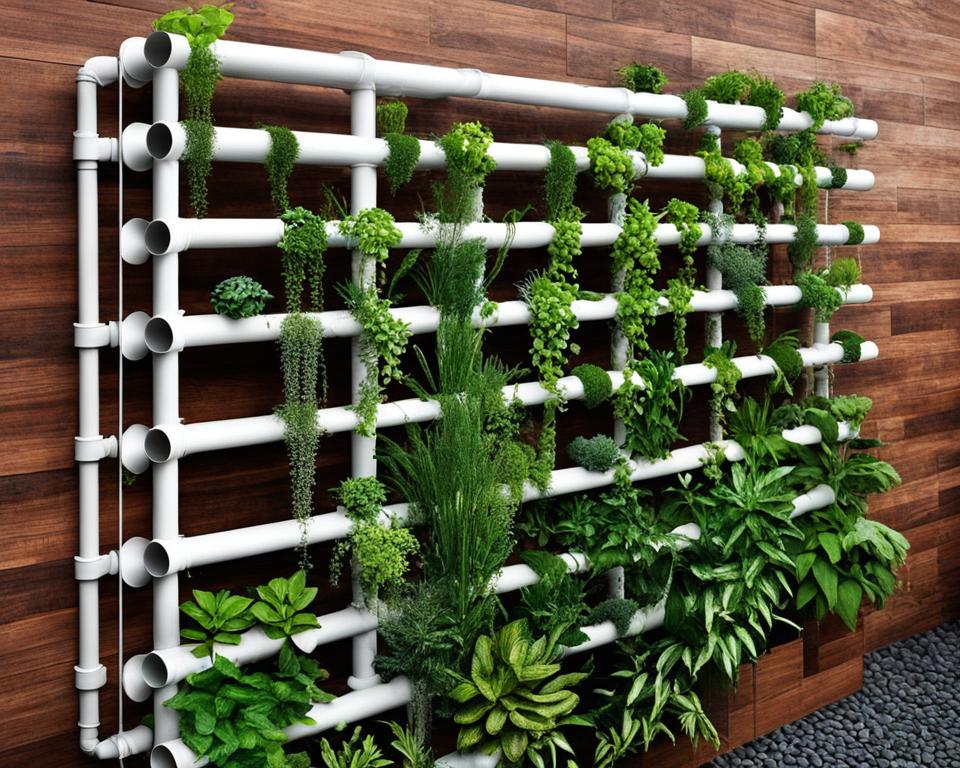Imagine transforming your limited space into a flourishing oasis. With vertical gardening using PVC pipe, this vision can become a reality right on your balcony or wall. This DIY project allows you to reap the benefits of gardening without the need for expansive plots of land. A vertical garden made with PVC pipe is not only efficient and versatile, but it also opens up a world of creative possibilities, from lush herb gardens to a cascade of blooming flowers. Consider this your roadmap to crafting a bountiful vertical landscape that defies gravity and expectations alike.
Key Takeaways
- Discover how to utilize PVC pipes to create a space-saving and productive vertical garden.
- Learn the steps to construct a stable and durable DIY vertical garden setup with ease.
- Explore a variety of PVC pipe vertical garden ideas that can bring both edible and ornamental plants to life.
- Gain insights on the materials and tools required to start your vertical gardening journey.
- Embrace the beauty of vertical gardening as a smart solution for gardening in small or confined spaces.
Embracing the Vertical Landscape: Benefits of Vertical Gardening with PVC Pipe
Vertical gardens are transforming urban landscapes, and vertical gardening with PVC pipe is at the forefront of this green revolution. These systems are not just a testament to horticultural innovation; they are a sustainable solution for city dwellers craving a slice of nature. Imagine harvesting your own cucumbers or enjoying fresh basil right from your balcony garden. With vertical vegetable gardening with PVC pipe, these dreams are entirely possible.
- Space Efficiency: PVC pipes offer a compact solution, making the most of vertical spaces on walls and balconies.
- Diversity: A broad spectrum of plants can thrive in a vertical gardening system with PVC pipe, including ornamental flowers and a variety of vegetables.
- Customization: Tailor the size and design according to your personal taste and available space, ensuring you have a system that’s easy to manage and pleasing to the eye.
- Affordability: Relatively inexpensive compared to other gardening structures, a vertical hydroponic gardening with PVC pipe system minimizes costs without sacrificing quality.
- Accessibility: Perfect for urbanites, a PVC pipe vertical garden requires minimal horizontal space, inviting greenery into even the smallest living areas.
By introducing a vertical gardening system with PVC pipe into your home, you not only contribute to a sustainable environment but also to your wellbeing. Such systems serve as natural air purifiers and stress relievers. Not to mention, they’re visually stunning elements that can enhance aesthetics and improve the quality of life.
Vertical gardening also opens a door to a world of self-sufficiency. It’s a gratifying journey—a tangible connection between nurturing and nature’s bounty. And when the fruits (or vegetables) of your labor are ripe for the picking, the satisfaction will be as rich as the flavors on your plate. So dig into the vertical way of life and embrace the bountiful possibilities that await with vertical vegetable gardening with PVC pipe.
Choosing Your PVC Pipe: Safety and Sourcing for Garden Use

If you’re venturing into the realm of pvc pipe vertical garden ideas, one essential factor to consider is the type of PVC pipe you choose for construction. For your vertical gardening with PVC pipe project, it’s highly advisable to opt for new Australian-made PVC pipes that are certified for carrying potable water.
Why Australian-made, you might ask? Here’s a compelling reason: Australian standards for PVC pipes are stringent, ensuring they’re devoid of harmful chemicals that could leach into the soil and, consequently, into your plants. This is particularly crucial if your vertical garden will include edibles. Your health, and the health of your garden, should take precedence.
When selecting PVC pipes for your garden, here’s what you should look for:
- New and unused pipes to eliminate the risk of contaminants that may have accumulated in used or repurposed pipes.
- Confirmation that pipes are suitable for carrying potable water, which ensures the PVC is safe for plant growth, especially for plants you plan to consume.
- Verification that the pipes are toxin-free and not manufactured with any dangerous chemicals or lead-based stabilizers.
Sourcing the right materials is a step toward successfully establishing a flourishing vertical garden. Remember, with the right selection of materials, you’ll be well on your way to harvesting safe to eat, and delicious, home-grown produce.
By ensuring the safety and suitability of the PVC pipes you employ, you’re not just committing to a method of space-saving gardening but also to cultivating a healthy and eco-conscious lifestyle. So, take the time to find the best quality PVC pipes for your vertical gardening with PVC pipe adventure, and you’ll reap the benefits of clean, green food that’s healthy for you and your family.
Vertical Gardening with PVC Pipe: Getting Started with the Right Materials
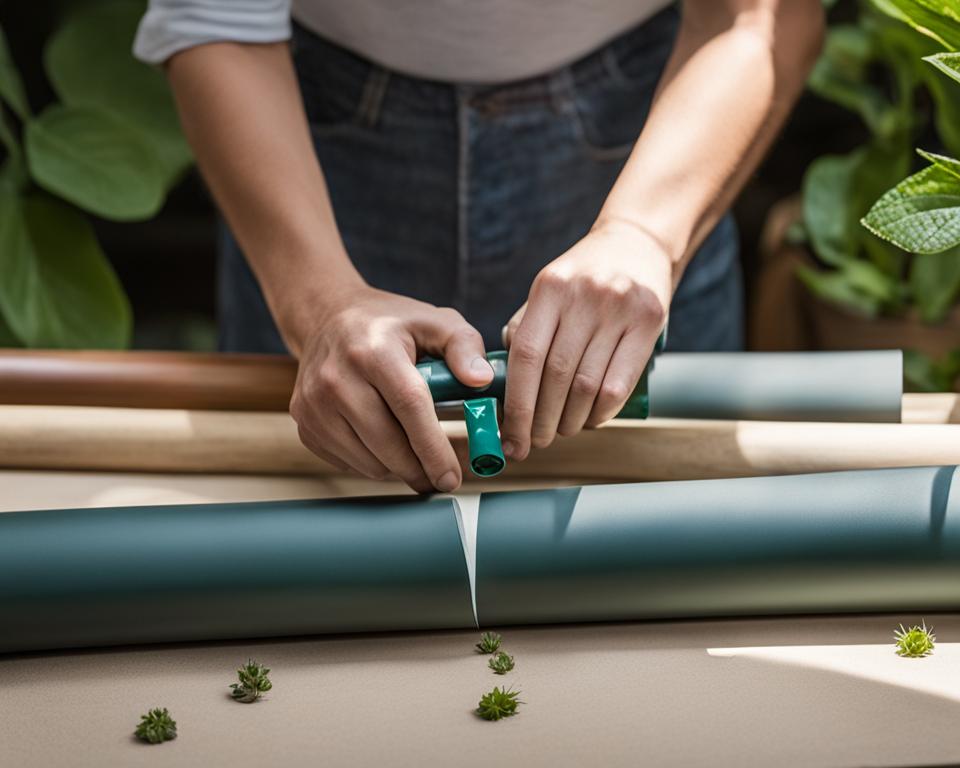
Embarking on a DIY vertical gardening venture with PVC pipes is an exciting prospect for urban gardeners looking to maximize their space. To set yourself up for success, an essential first step is to determine the requirements for your customized garden. Proper measurement and the right set of tools will enable you to create an efficient and prolific vertical garden.
Measuring for Space Efficiency
Before diving into the assembly of your vertical garden, measuring your available space is crucial. After all, pvc pipe vertical gardening is designed to make the most of limited areas. Start by calculating the height and width of the space where you intend to install your garden. This will help you ascertain the number of PVC pipes you’ll need and their optimal lengths, ensuring every inch of vertical real estate is used productively.
Selecting Tools for Cutting and Assembly
Your toolkit for creating a DIY vertical gardening with PVC pipe setup is the foundational element of the construction process. Securing your PVC pipes with bar clamps will keep them steady as you cut, while a reliable saw is indispensable for making those precise incisions. With a combination of hacking or reciprocating saws, cuts will be clean and to the right size. The assembly stage will require a drill and hole saw bit designed for creating perfect circles for your plant holes. Lastly, a metal file will be your best friend to smooth out any rough edges, ensuring a safe environment for plant growth and easy maintenance.
With careful planning and the correct materials in hand, you are now ready to build a robust and eye-catching vertical garden that will transform your gardening experience and yield fantastic results.
Designing Your PVC Pipe Vertical Garden: Layout and Aesthetics
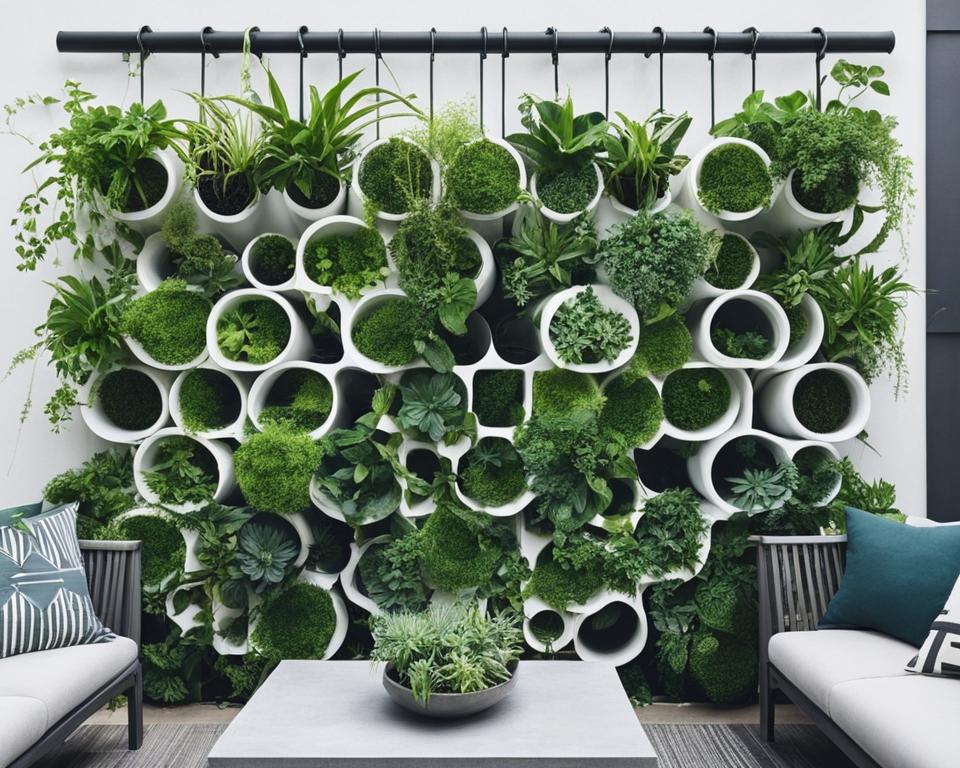
Creating a vertical garden made with PVC pipe is an innovative way to enhance your space with greenery while also being a delightful design element in its own right. The design process involves both visualizing the end result and ensuring practicality for plant growth and maintenance. Crafting a PVC pipe vertical garden demands careful consideration of both the layout and the aesthetic you aim to achieve.
Consider starting with a pvc pipe vertical garden idea that harmonizes with your area’s orientation and sunlight exposure. A symmetrical arrangement of PVC pipes can lead to a modern, orderly garden look, which is both appealing and straightforward to manage. However, for a more eclectic vibe, varying the pipe lengths and plant types can add depth and intrigue to your garden space.
A well-designed vertical garden made with PVC pipe not only serves as a stunning visual feature but also encourages biodiversity, creating a habitat for beneficial pollinators right outside your window.
When it comes to the garden’s feel, texture, and color, your choice of plants can dramatically affect the visual impact. A singular species can create a sleek, uniform look, while a mix of plants adds a burst of color and variation. Below is a table to help you envision possible layouts for your PVC pipe vertical garden.
| Layout Type | Description | Plant Suggestions |
|---|---|---|
| Uniform | Evenly spaced, identical PVC pipes with the same plant variety for a consistent look. | Ferns, Ivy, or Begonias |
| Staggered | PVC pipes arranged at varying heights and lengths to create depth and interest. | Succulents, Ornamental grasses, and Small flowers |
| Color-Coordinated | Pipes painted in different shades complementing the hues of chosen plants. | Marigolds, Petunias, and Fuschia |
| Mixed Variety | A combination of plant species for a diverse, textured appearance. | Herbs, Edible greens, and Seasonal flowers |
| Themed | A thematic approach based on color, scent, or plant type like a ‘salad’ or ‘fragrance’ garden. | Culinary herbs, Aromatic herbs, or a Collection of Salvias |
In conclusion, your pvc pipe vertical garden ideas should not only fulfill the need for a functional gardening space but also grant you the freedom to express your aesthetic preferences. It’s your canvas; by combining the practicality of PVC with a touch of creativity, you can create a living artwork that grows and evolves with each season.
Cutting and Assembling PVC Pipes: A Step-by-Step Guide
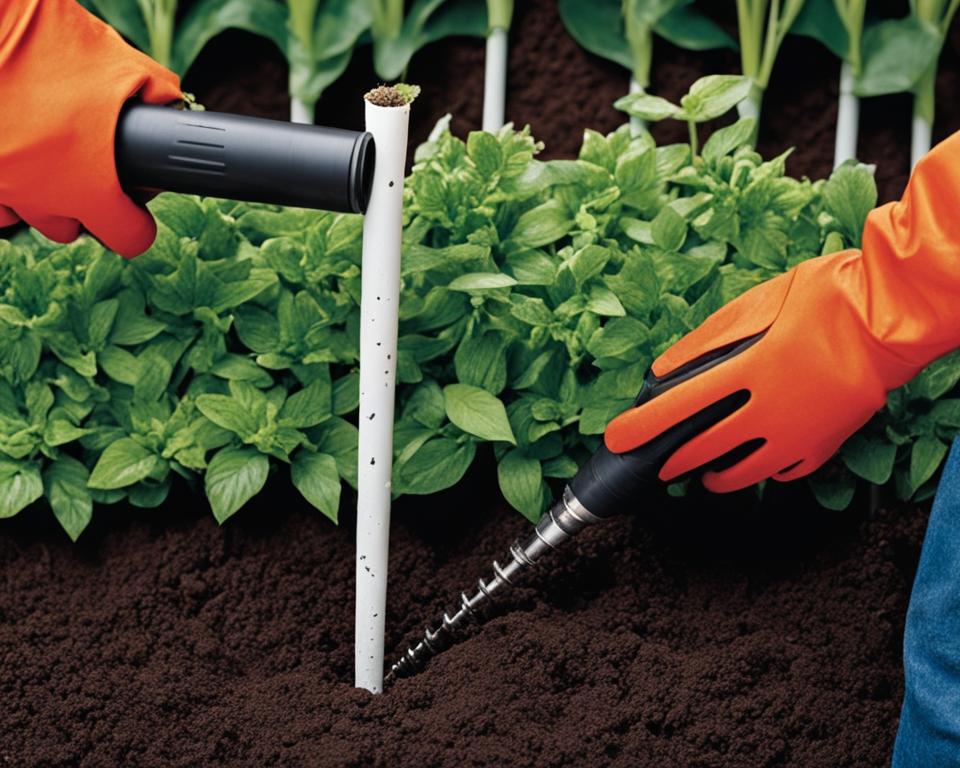
Embarking on the journey of pvc pipe vertical gardening requires methodical steps to ensure your garden’s foundation is strong and sustainable. With a focus on crafting the optimal environment for your plants, meticulous attention to detail during the cutting and assembly phase will set the stage for a flourishing vertical garden with PVC pipe.
Marking and Making Planting Holes
Begin by laying out your PVC pipes and securing them firmly to prevent movement as you work. Measure and mark with a white or silver marker for uniformity—the recommended distance between planting holes is typically 6-8 inches. This spacing allows ample room for plants to grow without competing for nutrients and sunlight. Next, take a 1-3/4-inch hole saw bit attached to your trusty drill and create the holes with precision. Post-drilling, it’s imperative to eliminate any sharp edges using a metal file, ensuring your plants have a smooth entry and are safeguarded against potential damage.
Ensuring Proper Drainage with Strategically Placed Holes
After the planting holes are made, shift your attention to the integral irrigation pipeline. Taking a smaller PVC pipe, drill holes throughout with a 3/16-inch drill bit to enable adequate water flow to each plant. It’s essential to cover this pipe with weed block fabric, secured with zip ties, to prevent soil from clogging the efficiency of your watering system. This deliberate strategy not only encourages proper drainage but also ensures each of your plants receives the moisture it needs, directly at the roots.
| Step | Action | Tools Required | Tip |
|---|---|---|---|
| 1 | Secure PVC pipes | Clamps, work table | Ensure pipes are immobile for precise cutting. |
| 2 | Mark for drilling | Marking tool | Mark at 6-8″ intervals for optimal spacing. |
| 3 | Drill planting holes | Drill, 1-3/4″ hole saw bit | Apply steady pressure for clean cuts. |
| 4 | File rough edges | Metal file | Smooth out edges to protect plant stems. |
| 5 | Prepare irrigation pipe | Drill, 3/16″ drill bit | Wrap with weed block fabric after drilling. |
By following these steps, your efforts in vertical gardening with PVC pipe will be rewarded with a unique and efficient garden structure. As your vertical garden takes shape, revel in the knowledge that with each precise cut and drill, you’re crafting not only a garden but a testament to sustainability and innovation in urban agriculture.
Setting up the Irrigation System for Your Vertical Garden
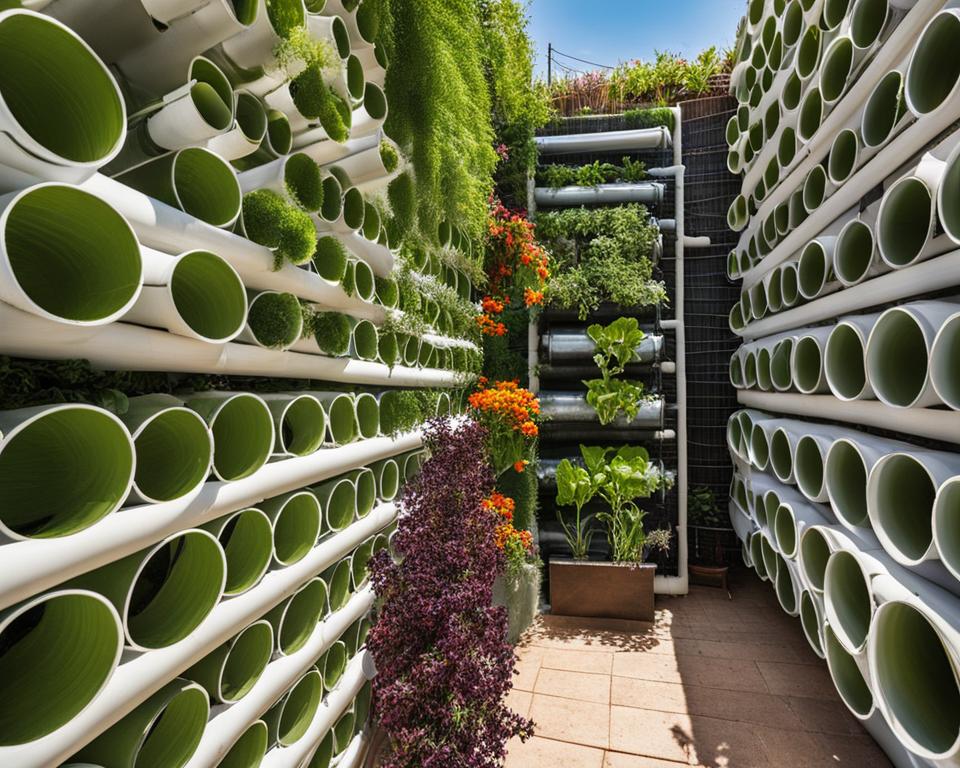
When undertaking DIY vertical gardening with PVC pipe, a critical component is the installation of an effective irrigation system. This system is the lifeline for your plants, ensuring they get the right amount of water to thrive. Here’s what you need to know to get your vertical garden’s irrigation up and running.
Firstly, select a location within your planter to position the large PVC pipe. This will act as the main support for your vertical garden. After placing it centrally, insert the smaller irrigation PVC pipe, which you’ve previously wrapped in weed block material. This step is essential for a successful vertical hydroponic gardening with PVC pipe setup.
To ensure the stability of your structure and the efficiency of the watering system, follow these steps:
- Add a layer of gravel at the bottom of the large pipe to act as an anchor.
- Pour stones or gravel into the planter until it’s filled to the halfway mark. This helps with drainage and prevents the garden from becoming top-heavy.
- Top the stones with a layer of soil, giving your plants a solid foundation for growth.
As you set up your irrigation system, remember:
Good irrigation is what separates a thriving vertical garden from a struggling one. It’s not just about watering the plants; it’s about ensuring each plant gets the exact amount of water it needs, exactly when it needs it.
With your irrigation system in place, you can look forward to the lush growth of your vertical garden. Follow these tips, and you’re another step closer to harvesting the rewards of your hard work and green-thumb skills.
DIY Vertical Gardening with PVC Pipe: Soil and Planting Techniques
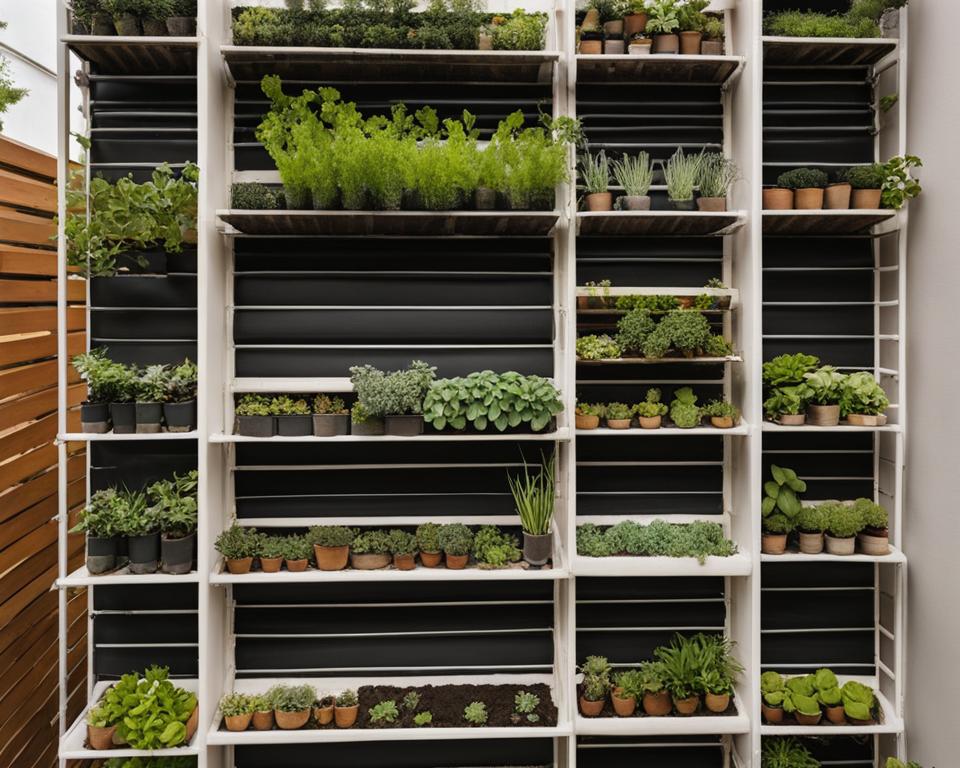
Creating a flourishing vertical garden begins with two crucial elements: selecting the right soil and choosing appropriate plants for your vertical garden. Understanding these components can transform your PVC pipe setup into a thriving green space, ideal for vertical vegetable gardening with PVC pipe or adding a floricultural touch to your area.
Selecting Soil and Adding Nutrients
When it comes to vertical gardening using PVC pipe, your choice of soil is a linchpin to success. A high-quality potting soil not only provides a secure base but also ensures that your garden has an abundance of essential nutrients. If you’re aiming for a garden that’s both resilient and productive, supplementing with additional organic fertilizers can promote stronger growth.
As you layer in the soil, maintain the irrigation pipe in the garden’s heart. Anchoring it with a cap during soil addition prevents any unwanted spillage or compaction in the system. This also assures that when you water your garden, moisture is evenly distributed to all plants.
Choosing Plants for Your Vertical Garden
The versatility of vertical vegetable gardening with PVC pipe offers a broad palette of plant options. Whether you aim for a vegetable bounty fitting for a chef’s pot or yearn for the kaleidoscopic vibrancy of flowers, your plant choices should reflect the sunlight, temperature, and humidity conditions specific to your garden’s locale.
Gently introduce your starter plants into the pre-cut holes in the PVC pipe. Each plant’s spacing needs careful consideration—tight enough to create a lush appearance but spaced well enough to allow room for growth. Evaluate the growth habits and needs of each plant species to ensure a robust and visually appealing vertical garden.
With these thoughtful steps in soil and plant selection, your vertical gardening using PVC pipe is poised to succeed. Here’s to a gardening venture that climbs to new heights!
Maximizing Plant Health: Tips for Watering and Maintenance
Ensuring your vertical gardening system with PVC pipe remains vibrant and productive hinges on mastering a reliable watering regimen. While embracing DIY vertical gardening with PVC pipe grants an innovative way to grow plants, it also requires a nuanced understanding of their unique watering needs. Proper hydration without excess is the balance to strike for peak plant health.
Understanding the Watering Needs of a Vertical Garden
Vertical gardens, especially those using a PVC pipe structure, demand diligent attention to moisture levels. The design of your vertical gardening system with PVC pipe should feature an effective drainage system to avert waterlogging, which can spell doom for roots and soil aeration. By integrating a bespoke irrigation pipe within your setup, water is delivered evenly, mimicking more natural growth conditions.
| Watering Technique | Benefits | Frequency |
|---|---|---|
| Irrigation Pipe System | Uniform distribution of water. | Varies on climate and plant type. |
| Manual Watering | Control over water applied to each plant. | Daily or bi-daily for most herbs and vegetables. |
| Self-Watering Containers | Less frequent watering periods. | Weekly checks and refills as needed. |
With proper guidance, you can administer water effectively, ensuring your garden never thirsts for too long nor drowns in excess. It’s a fine art, but once mastered, leads to a lush cascade of growth—a testament to your care and the resilience of your vertical gardening system.
PVC Pipe Vertical Garden Ideas: Customizing Your Green Space
Embracing vertical gardening with PVC pipe allows you to infuse your personal touch into the canvas of your home’s exterior or interior spaces. With a few inventive twists, the utility of PVC transforms into a visual celebration of lushness and creativity. Let’s explore how to bring character and life into your vertical garden designs, enhancing the beauty of your green space.
Incorporating Creativity with PVC Pipe Layouts
When considering the architecture of your vertical gardening using PVC pipe, the visual layout can significantly impact the overall aesthetics of your space. Go beyond the conventional with these inspired arrangements:
- Stagger the PVC pipes at varying heights to create a dynamic, cascading effect for your plants.
- Design a geometric pattern for a crisp, modern aesthetic that captures the viewer’s interest.
- Arrange your PVC pipes to form the initials of a loved one or a meaningful word, blending your green space with personalized expression.
Adding Decorative Elements to Enhance Visual Appeal
With your layout set, it’s time to highlight the decorative aspects of your pvc pipe vertical wall garden:
- Consider painting your PVC pipes with colors that harmonize or contrast with your home’s palette, depending on the desired visual impact.
- Add charms or hanging ornaments that can dance with the wind, bringing movement to your vertical garden.
- Intertwine string lights around your vertical structure for a magical twilight atmosphere.
To provide you with a clearer vision of possible plant choices and layout patterns for your vertical garden, the following table summarizes some popular options:
| Plant Type | Layout Design | Suggested Color Scheme | Decorative Elements |
|---|---|---|---|
| Edible Herbs | Linear, Horizontal | Earthy Tones | Culinary Themed Ornaments |
| Succulents | Geometric Patterns | Greens and Purples | Minimalist Accents |
| Flowering Plants | Staggered Heights | Bright, Vibrant Colors | Butterfly or Bird Decoys |
Allow yourself to imagine your space not just as a place to cultivate plants but as an artistic medium. With vertical gardening with PVC pipe, the options are wide open for you to customize and create an enchanting garden that captivates and inspires.
PVC Pipe Vertical Wall Garden: Expanding Gardening Horizontally
When you think of vertical gardening, the image that often comes to mind is of cascading greenery flowing top to bottom. Yet, a pvc pipe vertical wall garden flips this concept on its side—quite literally—allowing you to grow an array of plants horizontally along walls or fences. This ingenious twist to vertical gardening with PVC pipe meshes functionality with aesthetics, transforming barren wall spaces into vibrant ecosystems.
Especially in urban settings where ground space is at a premium, a vertical garden made with PVC pipe offers a unique opportunity to cultivate a garden without compromising limited floor area. It’s like painting with plants along your vertical canvas; every inch of your wall can be customized to become a part of your living domain.
Here is an instructive table on how to plant a successful PVC pipe vertical wall garden, which aligns your urban farming with burgeoning green trends.
| Plant Type | Light Exposure | Planting Instructions | Maintenance Tips |
|---|---|---|---|
| Edible Herbs (Basil, Thyme, etc.) | Full sun to partial shade | Use rich, organic potting mix | Regular harvesting encourages growth |
| Flowering Annuals (Petunias, Pansies) | Full sun | Plant top-heavy flowers lower to avoid tipping | Deadheading spent blooms promotes new flowers |
| Small Vegetables (Lettuce, Strawberries) | Full sun | Ensure adequate spacing for root development | Monitor for pests common in vertical spaces |
| Succulents (Sedum, Echeveria) | Full sun to light shade | Use cactus mix soil for proper drainage | Water deeply but infrequently |
By opting for a pvc pipe vertical wall garden, you’re embracing a seamless blend of horticultural form, function, and artistry. As you position your PVC pipes, consider the sun’s trajectory and the natural growth habit of your selected plants to optimize their health and beauty. This approach not only improves air quality but also provides the joy of growing and harvesting your own plants—right from the comfort of your balcony or courtyard. It’s a lush leap into the future of vertical gardening with PVC pipe, where every patch of sun-kissed wall is a new opportunity to create, grow, and inspire.
Conclusion
As we’ve delved into the world of vertical gardening with PVC pipes, it’s evident that this method of cultivation offers significant advantages, particularly when it comes to optimizing limited space. You have learned that with a DIY vertical gardening with PVC pipe approach, not only do you utilize your area efficiently, but you also add a layer of aesthetic beauty to your home. Creating a vertical vegetable gardening with PVC pipe setup isn’t just about maximizing space; it’s about transforming your living environment with vibrant greenery and fresh produce just an arm’s reach away.
Reflecting on the Rewards of Vertical Gardening
Reflecting on the steps and strategies you’ve encountered in this article, it becomes clear that a vertical gardening system with PVC pipe allows you to grow a plethora of plants, from succulent strawberries to luscious lettuce, in a manner that traditional ground-based gardens may not. The satisfaction derived from building your system, planting your garden, and watching it thrive is a testament to the empowering effect of taking control of your food source and surrounding yourself with nature’s bounty.
Taking the Next Steps: Advancing Your Green Thumb Skills
Your journey into vertical gardening doesn’t end here. As you delve deeper into refining your DIY vertical gardening with PVC pipe techniques, each new harvest cycle is an opportunity to enhance your green thumb. Embracing environmental stewardship and sustainable living, you become a part of a community dedicated to greener living practices. With each plant that flourishes, your skills grow, and so does the impact of your efforts. It’s a commitment to learning, growing, and flourishing — and your vertical garden made with PVC pipes is at the heart of it all.
FAQ
What are the benefits of vertical gardening with PVC pipe?
Vertical gardening with PVC pipe allows for efficient use of limited space, especially in urban settings. It is a cost-effective and adaptable method that can support a range of plants, from vegetables to flowers. It also enhances the aesthetic appeal of your garden area, providing structure and visual interest.
Is it safe to use PVC pipe for gardening?
Yes, it is safe to use PVC pipes for gardening, especially if the pipes are designated for potable water use and have no harmful chemicals. It is always recommended to use new, Australian-made PVC pipes for safety and quality reasons to ensure they are lead-free and safe for growing consumable plants.
What materials do I need to start vertical gardening with PVC pipe?
To begin vertical gardening with PVC pipe, you’ll need PVC pipes, bar clamps, a saw to cut the pipes, a drill with a hole saw bit, a metal file, stones or gravel, potting soil, mulch, starter plants, and an irrigation system.
How should I design the layout for my PVC pipe vertical garden?
The design of your PVC pipe vertical garden can be customized to fit your space and style preferences. Consider factors such as sunlight, plant type, and desired aesthetic when planning your layout. You can choose to create a uniform look with identical plants or a diverse garden with a mix of species.
How do I properly cut and assemble PVC pipes for planting?
Mark the pipes at intervals for planting holes, securing them to your work surface. Cut the holes with a hole saw bit and use a metal file to smooth edges. When assembling, consider the water needs of your plants and ensure you have an adequate irrigation system in place.
How do I set up an irrigation system in my vertical PVC pipe garden?
To set up an irrigation system, place a smaller PVC pipe wrapped in weed block fabric inside your larger PVC planter pipe. Drill holes in the smaller pipe to allow water through and fill the base with gravel to help anchor and stabilize the system.
What type of soil and plants are best for PVC pipe vertical gardening?
High-quality potting soil rich in organic matter is ideal for PVC vertical gardens. Choose plants based on sunlight and space conditions, your own preferences, and the plant’s growth requirements. Consider using a blend of plants for both functional and decorative purposes.
How often should I water my PVC pipe vertical garden?
Water your PVC vertical garden regularly, ensuring even distribution throughout each section. The frequency will depend on the climate, the type of plants, and their stage of growth, but be mindful that vertical gardens may dry out faster due to increased air flow.
Can I add decorative elements to my PVC pipe vertical garden?
Absolutely, incorporating decorative elements can enhance the visual appeal of your garden. Painting the PVC pipes, using decorative stones, or adding garden accessories can personalize your vertical garden and complement your home’s design.
How can I expand my gardening space using a PVC pipe vertical wall garden?
Expand your gardening space by installing PVC pipe planters horizontally along a wall or fence. This maximizes the use of vertical surfaces and turns an empty wall into a productive and beautiful green space.
What are the rewards of engaging in vertical gardening with PVC pipes?
Vertical gardening with PVC pipes offers the reward of maximizing spatial efficiency in smaller areas, increasing plant diversity, and enhancing your living space’s biodiversity. It’s an empowering practice that promotes sustainability and provides a unique gardening experience.
How does vertical gardening with PVC pipes help in advancing my gardening skills?
Vertical gardening challenges you to think creatively and spatially about plant growth. It hones skills in DIY construction, plant care, and innovative problem-solving. This method of gardening encourages continuous learning and adaptation, which broadens your horticultural expertise.

